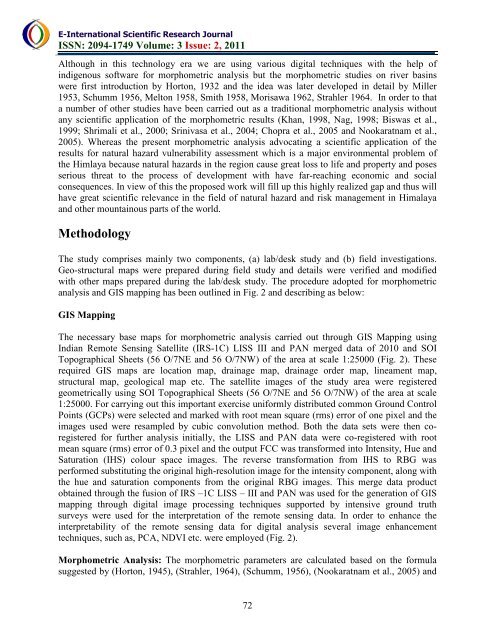download the full article here - E-International Scientific Research ...
download the full article here - E-International Scientific Research ...
download the full article here - E-International Scientific Research ...
You also want an ePaper? Increase the reach of your titles
YUMPU automatically turns print PDFs into web optimized ePapers that Google loves.
E-<strong>International</strong> <strong>Scientific</strong> <strong>Research</strong> Journal<br />
ISSN: 2094-1749 Volume: 3 Issue: 2, 2011<br />
Although in this technology era we are using various digital techniques with <strong>the</strong> help of<br />
indigenous software for morphometric analysis but <strong>the</strong> morphometric studies on river basins<br />
were first introduction by Horton, 1932 and <strong>the</strong> idea was later developed in detail by Miller<br />
1953, Schumm 1956, Melton 1958, Smith 1958, Morisawa 1962, Strahler 1964. In order to that<br />
a number of o<strong>the</strong>r studies have been carried out as a traditional morphometric analysis without<br />
any scientific application of <strong>the</strong> morphometric results (Khan, 1998, Nag, 1998; Biswas et al.,<br />
1999; Shrimali et al., 2000; Srinivasa et al., 2004; Chopra et al., 2005 and Nookaratnam et al.,<br />
2005). W<strong>here</strong>as <strong>the</strong> present morphometric analysis advocating a scientific application of <strong>the</strong><br />
results for natural hazard vulnerability assessment which is a major environmental problem of<br />
<strong>the</strong> Himlaya because natural hazards in <strong>the</strong> region cause great loss to life and property and poses<br />
serious threat to <strong>the</strong> process of development with have far-reaching economic and social<br />
consequences. In view of this <strong>the</strong> proposed work will fill up this highly realized gap and thus will<br />
have great scientific relevance in <strong>the</strong> field of natural hazard and risk management in Himalaya<br />
and o<strong>the</strong>r mountainous parts of <strong>the</strong> world.<br />
Methodology<br />
The study comprises mainly two components, (a) lab/desk study and (b) field investigations.<br />
Geo-structural maps were prepared during field study and details were verified and modified<br />
with o<strong>the</strong>r maps prepared during <strong>the</strong> lab/desk study. The procedure adopted for morphometric<br />
analysis and GIS mapping has been outlined in Fig. 2 and describing as below:<br />
GIS Mapping<br />
The necessary base maps for morphometric analysis carried out through GIS Mapping using<br />
Indian Remote Sensing Satellite (IRS-1C) LISS III and PAN merged data of 2010 and SOI<br />
Topographical Sheets (56 O/7NE and 56 O/7NW) of <strong>the</strong> area at scale 1:25000 (Fig. 2). These<br />
required GIS maps are location map, drainage map, drainage order map, lineament map,<br />
structural map, geological map etc. The satellite images of <strong>the</strong> study area were registered<br />
geometrically using SOI Topographical Sheets (56 O/7NE and 56 O/7NW) of <strong>the</strong> area at scale<br />
1:25000. For carrying out this important exercise uniformly distributed common Ground Control<br />
Points (GCPs) were selected and marked with root mean square (rms) error of one pixel and <strong>the</strong><br />
images used were resampled by cubic convolution method. Both <strong>the</strong> data sets were <strong>the</strong>n coregistered<br />
for fur<strong>the</strong>r analysis initially, <strong>the</strong> LISS and PAN data were co-registered with root<br />
mean square (rms) error of 0.3 pixel and <strong>the</strong> output FCC was transformed into Intensity, Hue and<br />
Saturation (IHS) colour space images. The reverse transformation from IHS to RBG was<br />
performed substituting <strong>the</strong> original high-resolution image for <strong>the</strong> intensity component, along with<br />
<strong>the</strong> hue and saturation components from <strong>the</strong> original RBG images. This merge data product<br />
obtained through <strong>the</strong> fusion of IRS –1C LISS – III and PAN was used for <strong>the</strong> generation of GIS<br />
mapping through digital image processing techniques supported by intensive ground truth<br />
surveys were used for <strong>the</strong> interpretation of <strong>the</strong> remote sensing data. In order to enhance <strong>the</strong><br />
interpretability of <strong>the</strong> remote sensing data for digital analysis several image enhancement<br />
techniques, such as, PCA, NDVI etc. were employed (Fig. 2).<br />
Morphometric Analysis: The morphometric parameters are calculated based on <strong>the</strong> formula<br />
suggested by (Horton, 1945), (Strahler, 1964), (Schumm, 1956), (Nookaratnam et al., 2005) and<br />
72

















